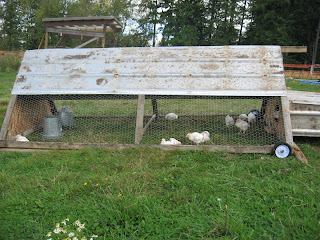We have 6 beehives, as of August 2010. Here is the full list:
L1, a Langstroth started in 2009 from a package. We harvested two frames in 2009, and two frames in 2010. It swarmed in Spring 2010 (we were moving at that time, I did not have time to manage it properly).

W1, a home made Warré, started in 2010 from a package. No harvest on this hive, but it is doing fine, with two full bodies at the end of the summer:

W2, a home made Warré, started in 2010 from a package. One comb harvested in 2010. This hive is doing well, with 3 bodies full by August. It will overwinter on 4 bodies:

W3, a home made Warré, started in 2010 from a package. This was my best 2010 hive, but I let it starve by mistake, insufficient feeding. The surviving bees were merged with K1. W3 spot is free, and it will be replaced in 2011.

L2, a Langstroth from a 2010 package. It is installed at a friend's house. It is doing OK, with 1 and 1/2 bodies filled.

K1, a small wild swarm from 2010. This is Kristen's hive. K1 never really developed, and it was pushed by a goat, which broke all the combs. K1 will likely not survive the winter, but I will give it a chance by feeding it during September/October.

W4, a home made Warré from L1 swarm. It is installed at a friend's home. Because I did not have the hive ready when L1 swarmed, the top body is actually a Langstroth Medium. W4 appears to be doing good, but is due for inspection and maybe harvest. All other hives were already inspected and partially prepped up for winter.

Total, we harvested 0.7 gallon of honey (without counting W4). It looks mostly blackberry honey, very clear and liquid. We harvested it by slicing the combs with a knife over a strainer, then filtering.
Next year I have requests for more hives, about 3 or 4 more hives. I hope that by Spring 2012, I will have 10 hives that will have successfully overwintered.





















































